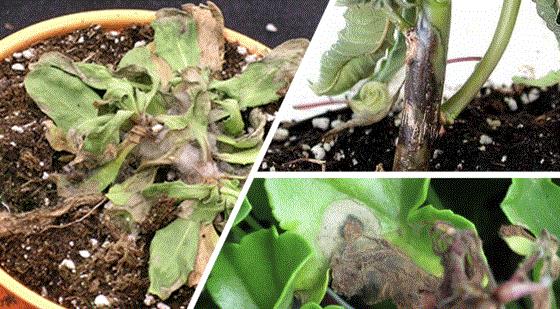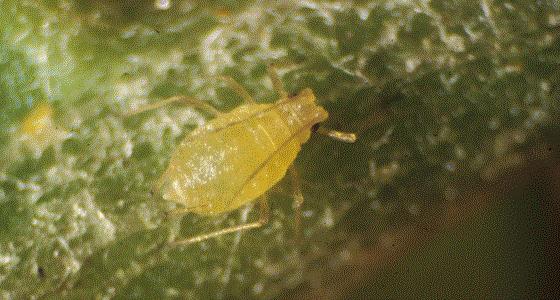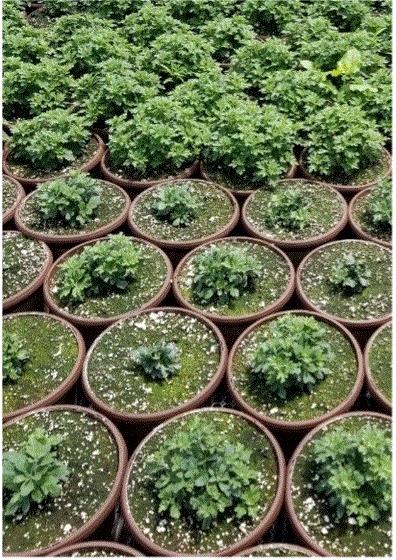Summer is Coming … Are You Ready?
Sure, it’s a nippy 45F in Cleveland as I’m writing this—and spring hasn’t even started here in the Midwest—but it’s not too early to start preparing for summer production and the specific diseases to keep on your radar. As you’re walking spring crops, loading carts or driving to and from long days in the greenhouse, tune into a past episode of the Tech On Demand Podcast, brought to you by GrowerTalks, that offers tips and tricks for managing warm-season diseases.
In GREENHOUSE AND NURSERY DISEASES: FOCUS ON SUMMER, I’m joined by Dr. Ann Chase, owner of Chase Agricultural Consulting, and Dr. Aaron Palmateer, a long-time ornamentals technical guru and greenhouse educator who’s now the director of agronomy at Harrell’s. Both are expert plant disease researchers with decades of combined work in the field.

After my guests reflected back on spring production challenges for a bit, they jumped right into the warm-season diseases like Phytophthora, Rhizoctonia, soft rots like Erwinia, Southern Blight, Xanthomonas and plenty more. They discussed what they’ve see in greenhouses and nurseries early in the season and what they expect to see as summer progresses—more than 25 diseases they’ve seen first-hand.
One of the most interesting parts of this 'cast is a rundown of common diseases and the temperature ranges that bring them on. The episode continued with thoughts on why producing some crops out of season (such as vinca, poinsettias and fall pansies) often requires the most vigilance and hardest work by production teams. They concluded with an in-depth look at the most cutting-edge control strategies for summer diseases.
This episode (AND 115 MORE) can be found on SPOTIFY, APPLE PODCASTS and just about any other podcast platform you use. Be sure to subscribe so you never miss an episode ... and if you have a minute to leave a positive review, it will be greatly appreciated!

Nick’s Tip of the Week: Managing Aphids in Finished Production
Each week, I work with my buddy Nick Flax, a technical services expert at Ball, to share a concern that’s come up during one of his numerous calls with growers across North America. This week, he’s been thinking ahead about pest questions that might be hitting his inbox and phone soon—namely aphids.
PROBLEM: As Bill mentioned above, the weather will soon start to warm up more consistently, even in Northern regions, and that means pest pressure from overwintering insects in the landscape will no doubt increase. I’m expecting to get an influx of questions from many of you on how to manage sudden infestations.

NICK’S TIP: I always anticipate questions on thrips and mites (and will certainly cover them when the time comes), but from my experience, aphids seem to be one of the more persistent challenges for growers at Mid-Atlantic latitudes and further north in late-spring and summer. You will experience aphid pressure on all different ages and stages of crops, so let’s go over some dos, don’ts and strategies for managing aphids in finished production.
Whether you’re receiving new plugs or liners, have a recently planted crop, or have a batch of mature, finished plants, early action and preventative measures are critical to managing aphids:
-
Thoroughly inspect incoming young plants. Suppliers do their utmost to ship pest-free plants, but the reality is there’s no such thing as a 100% “clean” plug or liner. If you receive heavily infested trays, however, it’s best to avoid planting them. Contact your supplier ASAP and quarantine infested trays away from your greenhouse until a resolution is reached.
-
Apply preventatives at (or shortly after) transplant. If you want to implement an effective biological IPM program in your operation, release aphid predators and parasitoids as soon as your crops hit the bench. Continue releasing biological control agents (BCAs) to keep the pressure on and ensure that your bios continue to outnumber the aphids, especially as the weather outside becomes more conducive to “waking up” dormant critters.
-
If BCAs aren’t the best strategy for your operation, apply softer chemistries with systemic or translaminar activity (like insect growth regulators [IGRs]) at transplant (for example, a plug and liner dip) or shortly thereafter. Products like these are most effective when crops have time to take up active ingredients and distribute them throughout the plant before aphid pressure mounts. Always check the label, as some IGRs can cause phytotoxicity on certain species when they're immature but are safe to apply to mature crops.
-
Monitor early and often. Place sticky traps in your crops (close to the canopy) as soon as they hit the bench. Give your sticky cards a quick glance at least once daily and do a more thorough bug count weekly to better understand if you have aphids or if numbers are spiking. Aphid populations can explode quickly, especially as the weather gets warmer.
-
Don’t wait until aphid pressure is out-of-hand. Ramp up control measures when the number of aphids on your sticky cards each week starts to increase.
-
Manage pressure as the crop matures. The longer a crop is on your bench or basket line, the greater the likelihood that aphids will pop up. Calibrachoa and verbena baskets are often the first mature crops that I see major aphid outbreaks on each spring, so be sure to re-up on your systemic or translaminar preventative controls as the efficacy window reaches its end.
If a major outbreak occurs, find the hot spot(s), and dispose of heavily infested pots or baskets. It’s a shame to throw away plants that are close to ship, but this is ultimately the easiest and cheapest way to quickly reduce the aphid population in your greenhouse. Once hot spots are rogued out apply a contact insecticide, and make sure you have achieved good coverage throughout the canopy. If possible, quarantine the infested crop or house and ramp up monitoring in adjacent production areas. Reactive spraying like this can sometimes chase aphids into untreated crops nearby, so keep your head on a swivel.
Lastly, follow-up with a systemic insecticide drench or heavy spray with a translaminar product with some staying-power to provide longer-term protection and mop-up effect for any stragglers. Be aware of potential risks to pollinators if your crops are budding or in-flower and are going to retail soon, and use lower-toxicity insecticides whenever possible if this is the case.

Quick Tech Tip: Low P … What to Do?
In the photo below, the same varieties were planted on the same day, but this grower ran out of soil and planted into another media. All the plants were fertilized at every other watering and there was slow-release fertilizer in the mix. After four weeks, it was clear that the group in the foreground were locked up and not growing. What caused this?

The media in the foreground had field soil in it that was amended with gypsum, which raised the EC of the soil to above 3.0 and due to mixing inconsistencies, there was 1 to 8 ppm phosphorous (P) in the soil. When excessive gypsum is incorporated in the mix (resulting in high salts) it’s important to keep the soil moist to minimize the salt effect. With the inadequate P in the mix, the plants will not grow without a P boost. An application of 9-45-15 (contains high P plus micros) will give the plants the kick to resume growth if the soil is kept moist.
Dropping pH for Perennial Production
The Tech On Demand team recently heard from a grower who needed help dropping the pH on his lupine crop from about 7.2 to closer to 6. In this production location (a cold house), the grower did not have an injector but was hoping to use granular aluminum sulphate—Al2(S04)3.
Of course, there’s a plant nutrition expert on the Ball Seed Technical Services team, which is always helpful! Dr. Josh Henry shared these tips:
First off, we need to know whether the aluminum sulphate is a water soluble or a controlled-release granule. I assume the granular aluminum sulphate is soluble? Most growers using aluminum sulphate to lower pH are using controlled release (polymer coated) material that is safe to top dress with, and it is used primarily in hydrangea production. If it’s controlled release, I’d recommend using the low rate that’s on the label.

In general, water-soluble material should not be directly top-dressed and should instead be mixed and applied as a drench. This of course requires an injector, unless you can mix up a large barrel of dilute aluminum sulphate to apply by hand to each pot. Depending on the size of the crop, this is likely an impractical solution.
My best recommendation would be to invest in some type of injector. Even a Hozon siphon injector (available from most greenhouse supply companies) would be incredibly helpful given how inexpensive they are (around $35).
General rate recommendations for aluminum sulphate are 1 to 3 lbs. per 100 gal. (diluted). Remember to rinse off the foliage after application to prevent phytotoxicity!
As an alternative to aluminum sulphate, they could also use iron sulfate (FeSO4) at similar rates to lower the pH. Keep in mind that large quantities of Fe or Al can become toxic to the plant, so it’s likely better to apply a low rate initially and make a follow-up application if the pH is still too high. I can’t say for sure, but because FeSO4 is a more common recommendation, I would suspect that it is a safer material to apply to most crops.
Additionally, if the grower invests in an injector, they can fertilize with an acidic fertilizer like 20-10-20, which would help to bring the pH down further and more safely. Anything high in ammoniacal nitrogen will help lower pH.

Thrips Parvispinus on Poinsettia?
I was surprised when I got an update from the research team at OMAFRA (Ontario Ministry of Agriculture, Food and Rural Affairs) about the potential of growers finding Thrips parvispinus on poinsettia crops later this year when production begins. But because I know the Ontario team is on top of this particular thrips and developing some of the best resources related to the pest, I quickly opened the email to learn more.
It's not yet time to sound the alarms, but let’s start with IPM specialist Sarah Jandricic’s comments in the conclusion of PARVISPINUS ON POINSETTIA? IT’S POSSIBLE:
“Thrips parvispinus are not a given in poinsettia. At this rate, we don’t know how much they like this host plant, or if this is more of a “crime of opportunity.” However, given that Parvispinus has the potential to disrupt biocontrol programs for Bemisia whitefly in this crop, early detection and intervention will be critical.”
The report details the fact that Thrips parvispinus has been found in many countries around the world—including some with greenhouses that supply poinsettias to countries producing large quantities of finished material (there’s a map in the article). Further making the point to stay vigilant is the fact that this particular thrips has been found on poinsettias in Europe. Unfortunately, the symptoms look a lot like western flower thrips damage, making it critical to stay on top of your pest ID game.

As you make your way through spring and prepare for poinsettia URCs to arrive in a few months, bookmark this article and share it with your team. Sarah and the researchers in Ontario included a data-driven discussion of the value of cuttings dips to combat the likelihood of Thrips parvispinus infestation in the article, as well as resources for scouting and identification.

Finish Line …
Wow! The number of posts and comments in our GREENHOUSE TECH TEAM FACEBOOK GROUP has been way up over the past few weeks. This makes sense with spring production in full swing and the speed at which the members of the group respond to peers in need of answers and suggestions. We’ve also had members posting pics of their beautiful and healthy spring crops, which is super cool to see!
If you’re not already a member of this peer-to-peer community, now’s the time to join! With more than 5,700 members around the world, when you post a question, you can expect comments within minutes. If you have knowledge to share, there are fellow greenhouse professionals who’d appreciate the info. And don’t worry … I approve all member requests to maintain the integrity of the group and make sure the folks involved are industry professionals and not hobbyists looking for free advice.
Hope to see you in the group!




Please feel free to send your comments, constructive criticism and topic ideas to me at bcalkins@ballhort.com.

Bill Calkins
Editor - Tech On Demand
This email was received by you and 25,930 other fine subscribers!
If you're interested in advertising in Tech On Demand, contact Kim Brown ASAP and she'll hook you up.